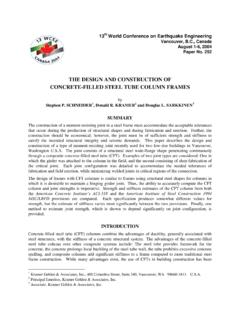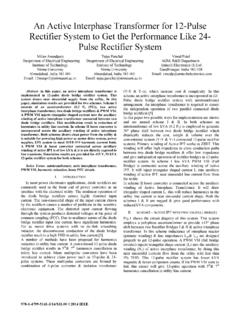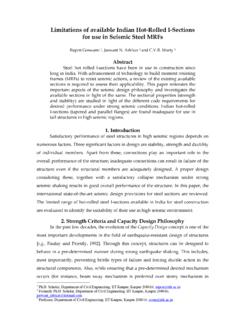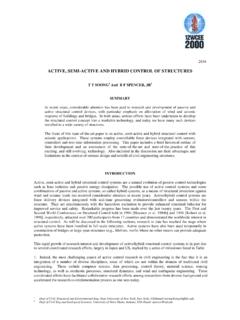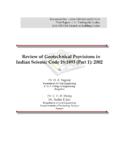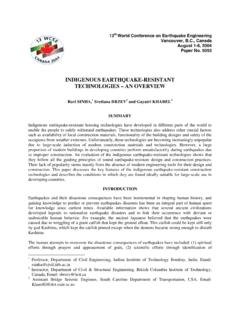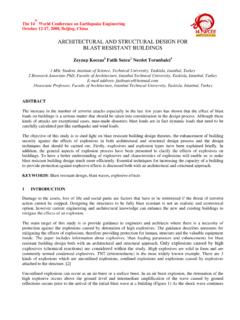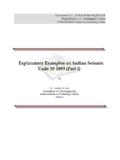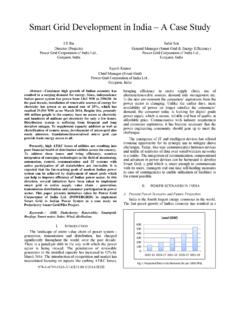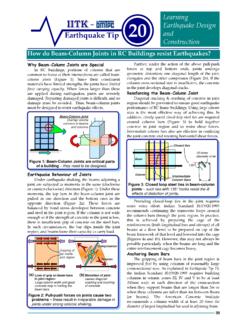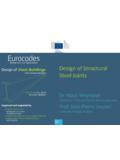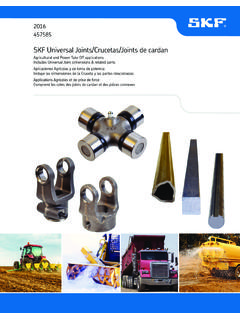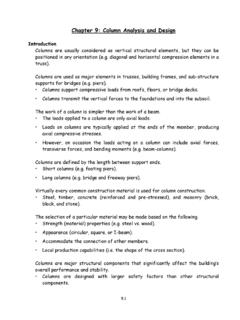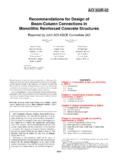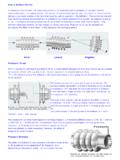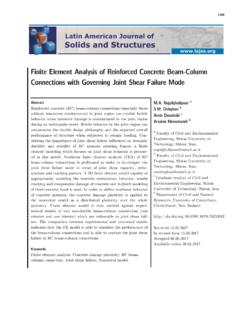Transcription of Seismic Behavior of Beam Column Joints in Reinforced ...
1 Document No. :: Final Report :: A - Earthquake Codes IITK-GSDMA Project on Building Codes Seismic Behavior of beam Column Joints in Reinforced concrete moment resisting Frames by Prof. A. Meher Prasad Deapartment of Civil Engineering Indian Institute of technology Madras Chennai Seismic BEHAVIOUR OF beam Column Joints IN Reinforced concrete moment resisting FRAMES - A REVIEW Uma 1 and A. Meher Prasad 2 1 Project officer, Department of Civil Engineering, IIT Madras, India 600 036 2 Professor, Department of Civil Engineering, IIT Madras, India- 600 036 Abstract The beam Column joint is the crucial zone in a Reinforced concrete moment resisting frame .
2 It is subjected to large forces during severe ground shaking and its behaviour has a significant influence on the response of the structure. The assumption of joint being rigid fails to consider the effects of high shear forces developed within the joint . The shear failure is always brittle in nature which is not an acceptable structural performance especially in Seismic conditions. This paper presents a review of the postulated theories associated with the behaviour of Joints . Understanding the joint behaviour is essential in exercising proper judgments in the design of Joints . The paper discusses about the Seismic actions on various types of Joints and highlights the critical parameters that affect joint performance with special reference to bond and shear transfer.
3 Dr. : Qualifications in Civil Engineering at PSG College of Technology, Coimbatore in Building Technology at Indian Institute of Technology, Madras in Structural Engineering, Indian Institute of Technology, Madras. Former Address: Present Address: Dr. Project Officer Research Assistant Department of Civil Engineering Department of Civil Engineering Indian Insititute of Technology Madras University of Canterbury Chennai, India 600 036 Christchurch, New Zealand.
4 E-mail: ; Prof. A. Meher Prasad, Department of Civil Engineering, IIT Madras, Chennai, India- 600 036. E-mail: INTRODUCTION In the analysis of Reinforced concrete moment resisting frames the Joints are generally assumed as rigid. In Indian practice, the joint is usually neglected for specific design with attention being restricted to provision of sufficient anchorage for beam longitudinal reinforcement. This may be acceptable when the frame is not subjected to earthquake loads. There have been many catastrophic failures reported in the past earthquakes, in particular with Turkey and Taiwan earthquakes occurred in 1999, which have been attributed to beam - Column Joints .
5 The poor design practice of beam Column Joints is compounded by the high demand imposed by the adjoining flexural members (beams and columns ) in the event of mobilizing their inelastic capacities to dissipate Seismic energy. Unsafe design and detailing within the joint region jeopardizes the entire structure, even if other structural members conform to the design requirements. Since past three decades extensive research has been carried out on studying the behaviour of Joints under Seismic conditions through experimental and analytical studies. Various international codes of practices have been undergoing periodic revisions to incorporate the research findings into practice.
6 The paper is aimed at making designers aware of the theoretical background on the design of beam Column Joints highlighting important parameters affecting Seismic behaviour of Joints . STRUCTURAL BEHAVIOUR UNDER Seismic ACTIONS The Seismic design philosophy relies on providing sufficient ductility to the structure by which the structure can dissipate Seismic energy. The structural ductility essentially comes from the member ductility wherein the latter is achieved in the form of inelastic rotations. In Reinforced concrete members, the inelastic rotations spread over definite regions called as plastic hinges. During inelastic deformations, the actual material properties are beyond elastic range and hence damages in these regions are obvious.
7 The plastic hinges are expected locations where the structural damage can be allowed to occur due to inelastic actions involving large deformations. Hence, in Seismic design, the damages in the form of plastic hinges are accepted to be formed in beams rather than in columns . Mechanism with beam yielding is characteristic of strong- Column -weak beam behaviour in which the imposed inelastic rotational demands can be achieved reasonably well through proper detailing practice in beams. Therefore, in this mode of Behavior , it is possible for the structure to attain the desired inelastic response and ductility. On the other hand, if plastic hinges are allowed to form in columns , the inelastic rotational demands imposed are very high that it is very difficult to be catered with any possible detailing.
8 The mechanism with such a feature is called Column yielding or storey mechanism. One of the basic requirements of design is that the columns above and below the joint should have sufficient flexural strength when the adjoining beams develop flexural overstrength at their plastic hinges. This Column to beam flexural strength ratio is an important parameter to ensure that possible hinging occurs in beams rather than in columns . beam Column Joints The functional requirement of a joint , which is the zone of intersection of beams and columns , is to enable the adjoining members to develop and sustain their ultimate capacity. The demand on this finite size element is always severe especially under Seismic loading.
9 The Joints should have adequate strength and stiffness to resist the internal forces induced by the framing members. Types of Joints in frames The joint is defined as the portion of the Column within the depth of the deepest beam that frames into the column1. In a moment resisting frame , three types of Joints can be identified joint , exterior joint and corner joint ( ). When four beams frame into the vertical faces of a Column , the joint is called as an interior joint . When one beam frames into a vertical face of the Column and two other beams frame from perpendicular directions into the joint , then the joint is called as an exterior joint .
10 When a beam each frames into two adjacent vertical faces of a Column , then the joint is called as a corner joint . The severity of forces and demands on the performance of these Joints calls for greater understanding of their Seismic behaviour. These forces develop complex mechanisms involving bond and shear within the joint . The objective of the paper is to review and discuss the well postulated theories for Seismic behaviour of Joints in Reinforced concrete moment resisting frames. Forces acting on a beam Column joint The pattern of forces acting on a joint depends upon the configuration of the joint and the type of loads acting on it.
